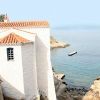HYDRA's History Featured
Hydra has been maned after the Island's plentyfull waters, which gushed from the founts that existed in the ancient times. Historians mention the island by the name Hydrea. In the interior of the Island have been found traces of ancient living quarters, according to archaeological excavations that took place in the location of "Episkopi".
The first residents of the island where called Dryopes. Hydra was used as a service station for the Greek navy, and as a result, it starred in the sea commerce with neighbouring countries and in communications.
Towards the end of the 18th century, Hydra was bloomming in export trade and commerce. It was that time which people of Hydra took advantage of the English-French war and earned for themselves great profits, by controling the sea commerce Important was the help of Hydra to the liberation of Greece in 1821.
During the war (1821), Hydra was in full alert and ready for battle with the turkish troop. It had got 130 battleships of 30.000 ton each, 5.400 soldiers and 2.400 cannons. The Captain of turks Hibraim called Hydra "Little England". The Hydrian fleet dominated the sea during the seven year war with the turks, contributing this way to the liberation of Greece, sacrificing many human lifes, battleships and money.
Hydra contributed to the Nation by giving to Greece one President, five Prime Ministers and Ministers:
- George Koundouriotis, who served as President of the Executive council during the Greek revolution. He was also council member during the Presidency of Kapodistrias and Othonas and also served as Prime Minister and Minister of Navy. (see also Kountourioti's George's & Pavlos Mansion & Museum)
- Antonios Kriezis, Prime Minister of Greece.
- Dimitrios Voulgaris, seven times Prime Minister.
- Athanasios Miaoulis, three times Prime Minister.
- Petros Voulgaris, Prime Minister.
Other personalities who came from Hydra, where the heroes of 1821, brothers Vokoi, I. Matrozos and A. Pipinos, the Admiral A. Miaoulis, the Captain A. Oikonomou, who rouse revolt to the Island, Iakovos and Manolis Tompazis (see also Tompazi's Mansion) and the Captains A. Tsamados (see also Tsamados Mansion), G. Sahtouris and G. Sahinis.
In 1912, the Hydrian admiral Pavlos Koundouriotis (see also Kountourioti's George & Pavlos Mansion & Museum), as Captain of the Greek fleet, won the turks. In 1924, Pavlos Kountouriotis was announced the first President of the Hellenic Republic.
In the same period, Nikolaos Votsis, torpedoed a turkish battleship outside the port of Thessaloniki. For over half a century, admiralties were administered by Hydrians. Also, we have to mention that Hydra gave birth to eminent personalities such as the Archbishop of Greece, Dorotheos Kottaras, and the Bishops Patsis, Parisis, Epiphanios, Kalaphatis and Prokopios Georgantopoulos. In sciences, the Academicians A. Lignos, I. Haramis, N. Hatzikiriakos-Gkikas (world famous academic & artist), P.Tetsis (Greek painter) and N. Nikolaou (artist).
Hydra reformed, developed and established during the 18th and 19th century. Then, the peopole of Hydra emigrated from the old town of Kiafa and settled in the port, around the Temple of Holy Virgin Mary (Kimisi). This part of the port and a part of Kiafa created the city that exists today. The settlement has got defensive character, as we see from the continuous building, the tall stone fences and the narrow paths. Many people from there are deserting the Island and immigrate to Athens and Piraeus, around the Church of Saint Nicolas, creating their own community.
Neolithic Period - Mycenean period - Archaic period
According to various archeological findings in the place Episkopi of Hydra, scientists have concluded that the emigration to the island had begun long before the Homeric period, meaning the after Neolithic time (3000 - 2600 B.C.). Hydra didn't manage, to the centuries that followed, to evolve in a place socially and historically capable of being. Hydria, as Herodotus used to call the island of Hydra, around the 13th century, is becoming the place of Driops farmers, fishermen and shepherds, who used to live to the Parnassus and Oiti.
Two centuries later, with the descent of Dorians, Driops are disappearing and so the life in the island. During Archaic times, Hydra didn't have to offer anything of Historical value. The island was probably under the command of the king of Mycenae, then it was bought from Hermions until 525 B.C and then again it was bought from political refugees from Samos to be given to trizinians, who wanted the island for farming and forager. A small number of Historians make references to Hydra. Among them are Herodotus, Ptolemaios the Geographer, Pausanias and the lexicographers, Stefanos the Byzantios and Isixios.
Classic times - Roman times - Byzantine times
The only testimony that we have for Hydra in Classis times is that of Stefanos the Byzantine, who refers to one of the inhabitants of the island by the name Euagis. We do not have enough information for Hydra in Roman and Byzantine times. This fact gave the impression that the island was uninhabited, but archaeological findings in the place Episkopi show different. It looks like that, because of pirate evasions from which most of the citizens left from the Island and others gone to the interior of it.
15th Century
In the beginning of the 15th century, Hydra was inhabited by a few shepherd families. From 1460, Arvanites refugees, who fought to the side of the Venetians against the Turks, came to the island and became fishermen. It is the time that the building spree starts in Hydra and the first town in the hill of the place Kiafa is created. 16th - 17th Century.
Because of the hostile climate in greek cities in conjunction with the pirates in Mediterranean, immigration becomes more intensive. Greek families immigrate to Hydra. Some of them were the Lazarou and Zerba family (from Hiperus), Mitarou family, Nega family, Gini family and Gouma family (from the island of Kythnos), Tompazi family (from Smirni), Tsamados family (from Kranidi), Oikonomou family (from Epidauros).
18th Century
More immigrants are coming to the small island of Hydra during the 18th century. That period we had the Venetian - Turk War and the Russian - Turk war. That's why in the start of the Greek revolution the island of Hydra had a population of 27.000 people. That had got positive results, especially in sea commerce and in shipping.
To the end of the 18th century Hydra became a great nautical power with 150 ships. The island is in its peak.
19th Century
In 1802 the administrative System in Hydra changes with the dispatch in the island of George Dimas Boulgaris, who was protigi of the Captain of the Turkish fleet. Boulgaris was assigned as commander of Hydra to call for order. Boulgaris's wise command and the Othoman likeness to his face, helped the island to be in the favour of the Turks. The pirate restraint and the economical blooming that Boulgaris managed to bring, gave the opportunity to the citizens of Hydra to organize their island the way they wanted, and because of the continuous battles they had to give with the pirates, all these turned them into fearsome sailors.
The eve of the Greek revolution finds the Island of Hydra economic and in terms of war, ready. It has got 120 battleships, 5.400 men and 2.400 cannons. The Revolution in Hydra was declared officially at the 16th of April 1821 from Antonios Ekonomou and the people that broke the reservations of the first. The island contributed to the naval efforts by sacrificing human lives, ships and money and bringing out leaders and fighters, like A. Miaoulis, A. Pipinos, M. Tobazis, A. Tsamados, G.Sahinis, G. Saxtouris, Kriezis and many more.
20th Century - Present times
During the 20th century the habitants were involved more systematically with fishing and sponges collection, an activity that gradually came to a total decline and did not manage to slow down the financial and population deterioration of the island. From the decade of 1950 Hydra was discovered by artists and producers of movies and since then the island was transformed to a cosmopolitan and most beautiful tourist center.
SOURCE: www.hydra.com














